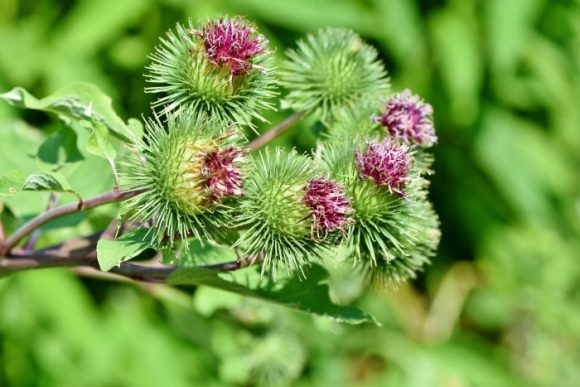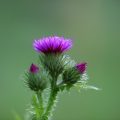- The Miraculous Shiny Bush Plant - January 18, 2021
- Colorful, Edible and Medicinal Celosia - January 10, 2021
- Radish, a Nutritional Power House - December 19, 2020
Burdock or thorny burr is native to Europe and Asia but has become naturalized to many regions of the world including North America. The plant belongs to the arctium genus in the asteraceae family and has two varieties: arctium lappa (greater burdock) and arctic minus (lesser or smaller burdock). Both are similar in appearance except for their difference in height, however, arctium minus is more common compared to the former. The plant is widely distributed and can be found growing along roadsides, in field borders and empty spaces.
[Disclaimer: Before eating or tasting any plant you find in the wild, make sure it is not poisonous as many wild edible plants have toxic look-alikes. In addition, The Right Flowers is not a medical site. Knowledge of and information about the therapeutic benefits and applications of flowers, while known through the ages, does not constitute medical advice. If you are having health issues, you should consult with a physician.]
Burdock has large leaves with a heart shape and purple flowers produced from spring to autumn. The plant is easily identified due to its globe-shaped flowers clustered around the top of the stalk featuring stiff, pricky hooks that cling to any passerby. The blossoms have a sweet fragrance which you can only pick up when you take a whiff at a close range. Burdock’s flowers are pink, red or purple with a striking resemblance to blossoms produced by bull thistle (cirsium vulgare).
The plant is highly versatile and is categorized by herbalists as an alterative herb which mean it has a positive effect on the lymph and blood and can be used for detoxification. In addition, Burdock has bitter properties which are great for boosting appetite and digestion.
All aerial parts of the burdock have a coating with a bitter taste. However, if you can endure the bitter taste of the coating, raw flowers, stalks, and leaves have a soft asparagus-like taste. The roots have a better taste with a parsnip-like flavor but are sweeter.
Barely opened flowers of the burdock plant and their stalks can be harvested in late spring and steamed or stir-fried for about 10 minutes or until they are soft. When cooked, these parts taste like artichoke.
Alternatively, you can separate the just-opened flowers from their stalks, peel the burdock stalks, chop them into tiny pieces and soak in cold water with a tablespoonful of vinegar for about 15 minutes. Boil the stalks for 10 minutes, toss in the chopped flowers and boil for another 5 minutes before straining. After straining, boil for an additional 5 minutes. Strain, stir-fry for 5 minutes and serve with fried chicken or duck.
Eating burdock may seem like a daunting task due to its bitter taste and burrs, but once you get past these hurdles, you realize that it is a great delicacy worth the trouble.





